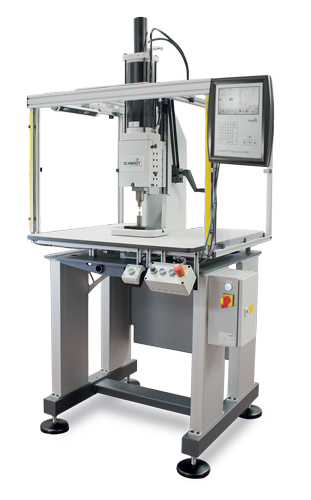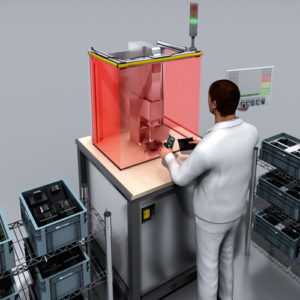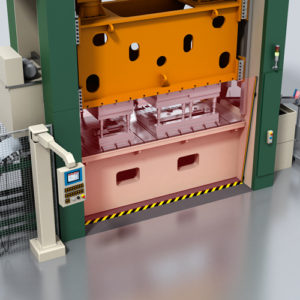
Presence Sensing Device Initiation (PSDI) refers to the use of a Presence-Sensing Device (often, though not limited to, light curtains) both to perform the safeguarding function and to initiate the machine cycle.
While this is not new technology, having been around for nearly half a century, PSDI has frequently been misunderstood, especially regarding when and where it is permissible to use PSDI in compliance with current safety standards and regulations. For example, many standards (including ANSI B11.1 for mechanical power presses) explain how to implement PSDI correctly, while OSHA prohibits the function on mechanical power presses in the US and US territories. This white paper clarifies what PSDI is, how it works, where it can and cannot be used, and the ways in which PSDI can not only ensure safety but also significantly increase productivity and throughput.
What Is PSDI and How Does It Work?
PSDI is an operating mode which utilizes a presence-sensing device to initiate a single machine cycle when it senses that work motions of the operator related to feeding or removing parts are completed and all parts of the operator's body are withdrawn from the sensing field of the device.
Traditionally, in applications with significant operator interaction, an operator is required to utilize hand or foot controls to manually start the machine after each interaction. The sequence begins when the operator places a part into the machine. Then the operator uses the hand controls to initiate the next machine cycle. And finally, once the hazard is no longer present (e.g., the hazardous motion has stopped moving) the operator can reach in, remove the part from the equipment, and begin the sequence again. While one cycle may only take a few seconds, the time it takes to operate the hand controls can accumulate, adding considerable time over a full production cycle/shift cycle compared to applications where that step has been eliminated. Compounded over hundreds or thousands of cycles per day on each machine, the negative effect on productivity and throughput adds up. But what if a single device per machine could eliminate that extra step? PSDI does exactly that.
 A light curtain with PSDI operates in the same way as a traditional light curtain (monitoring infrared beams for interruptions); however, logic is used to recognize interruptions in order for the device to determine when it is safe to initiate the next machine cycle. For example, when using PSDI on a machine, a single or double break (interruption) of the detection field of the safety device causes an automatic cycle initiation. In other words, when the operator’s hands enter the protected area during a hazardous portion of the machine cycle, the equipment will come to a stop, just like a typical light curtain application. However, for a single break application, the light curtain will also detect when the person’s hand(s) enter the protected area to remove the part; as soon as the person’s hand(s) leave the protected area, the next machine cycle can immediately begin. This eliminates the need for hand controls because the machine responds to the person’s actions automatically when implemented in a manner that complies with applicable safety regulations.
A light curtain with PSDI operates in the same way as a traditional light curtain (monitoring infrared beams for interruptions); however, logic is used to recognize interruptions in order for the device to determine when it is safe to initiate the next machine cycle. For example, when using PSDI on a machine, a single or double break (interruption) of the detection field of the safety device causes an automatic cycle initiation. In other words, when the operator’s hands enter the protected area during a hazardous portion of the machine cycle, the equipment will come to a stop, just like a typical light curtain application. However, for a single break application, the light curtain will also detect when the person’s hand(s) enter the protected area to remove the part; as soon as the person’s hand(s) leave the protected area, the next machine cycle can immediately begin. This eliminates the need for hand controls because the machine responds to the person’s actions automatically when implemented in a manner that complies with applicable safety regulations.
Why Use PSDI?
When properly applied, PSDI increases production efficiency, thereby reducing costs and improving operator health and safety.
Increase Productivity and Reduce Costs
By cutting down on the extra steps required by manual controls, each operator and each machine can complete more cycles at a faster rate. This not only increases production, but it also allows the companies to avoid investing in new machines in order to increase throughput of existing machines.
Depending on the application and the machine, implementing PSDI can increase productivity anywhere from 10% to 100%. The increase in production can pay for the PSDI system cost within months.
Improve Safety
There are important benefits in health and safety for the employees using a machine properly equipped with light curtains and PSDI versus a standard two-hand control or footswitch. In fact, it is important to note that manual controls do not offer safety advantages over properly installed safety devices with PSDI. While it may seem as though the operator retains more control over the machine function when using manual controls, in reality, the operator has a very similar level of control in both cases. With both manual controls and PSDI, the operator’s actions initiate each machine cycle. The difference is that with PSDI, the machine’s response is automatic.
In addition, with manual controls, accidents can occur due to unexpected contact with the hand or foot controls while reaching into the machine, or if a non-operator is assisting or adjacent to the machine. This problem is eliminated with PSDI safety devices because the manual controls are eliminated. Furthermore, safety devices with PSDI offer the added benefit of reducing worker fatigue and stress due to better ergonomics.
Where Can PSDI be Used?
PSDI is particularly useful in applications where there is frequent operator interaction with the machine. PSDI is best applied to equipment with:
- Continuous loading and unloading interactions of a single operator with a machine
- Quick cycle time processes, including metal forming (stamping, punching, bending or drawing), part assembly, welding, gluing and cutting
- High volume production, such as in the automotive and consumer electronics industries

Single break mode (single interruption of the protective sensing field to initiate the cycle) is generally the most efficient mode. Double break mode (the protective sensing field must be interrupted twice) can be effective for larger parts where the operator first penetrates the protective sensing field to remove a finished part, and then penetrates the field a second time to load a new part.
There are several circumstances where PSDI should not be used. For one, PSDI should not be used if the machine cannot be stopped immediately anywhere in its cycle. Additionally, PSDI cannot currently be used on any mechanical press in the US because the existing OSHA regulation 29 CFR 1910.217 requires PSDI be validated by an independent third-party organization recognized by OSHA; to date, OSHA has not yet recognized any such organizations.
However, PSDI can be used in many other machine applications, including but not limited to: hydraulic and pneumatic power presses (ANSI B11.2-2013), power press brakes (ANSI B11.3-2012), and robot systems (RIA TR R15.406-2014). Always consult with a safety professional to discuss your specific application before applying PSDI.
This post is meant as a guideline only and is accurate as of the time of publication. When implementing any safety measures, we recommend consulting with a safety professional.





